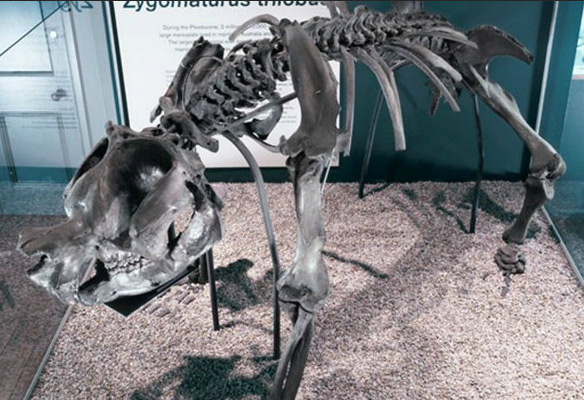
|
Search JoyZine with Google Site Search! |
Zygomaturus trilobus
An Australian megafauna species, Zygomaturus trilobus, is a relative of today's wombats, and was one of the largest marsupials to have ever existed, weighing up to 500kg. Its name derives from its prominent cheek-bones (zygoma), and its skull-structure also suggests that it had a three-lobed nose, and possibly a short trunk. Since its bones have only been found in former swamp-forests, it may have been semi-aquatic like a hippopotamus, scooping vegetation into its mouth with shovel-like incisors. Zygomaturus trilobus belonged to the now-extinct family Diprotodontidae, which in turn falls within the Infraorder Vombatomorphia, a group also including wombats and the marsupial lions (Thylacoleonidae). The diprotodontids were gigantic, lumbering herbivores and the largest of all marsupials. A complete skeleton of Z. trilobus was discovered by Mr E. C. Lovell in early 1920, while draining his selection at "Mowbray Swamp", now called Mella, three miles west of Smithton. Mr Lovell was no stranger to the remains of megafauna, having found another almost complete skeleton of Z. trilobus in the swamp ten years earlier. The 1920 skeleton was carefully excavated under the expert supervision of Mr Hubert Hedley Scott, the then-curator of the Queen Victoria Museum in Launceston. He proclaimed that the skeleton and the "very perfect skull", while stained brown by the tannic waters of the swamp, were well preserved by the prevailing anaerobic conditions. After excavation, the skeleton was acquired by Mr Kenneth M. Harrisson of Smithton, the district surveyor and a well-known megafauna collector for the Queen Victoria and Tasmanian Museums. Mr Harrisson presented the skeleton to the Tasmanian Museum later in 1920, in time for exhibition at the Science Congress held in Hobart in December of that year. Mr Scott and Mr Clive Lord, the curator of the Tasmanian Museum, formally described the specimen in a Royal Society of Tasmania paper published in 1920. |
